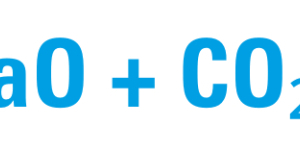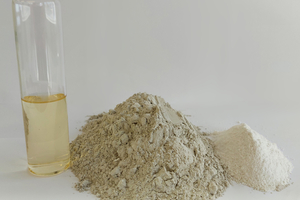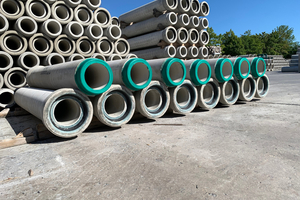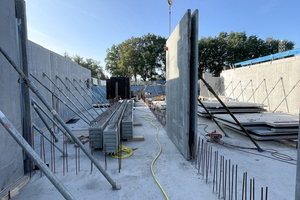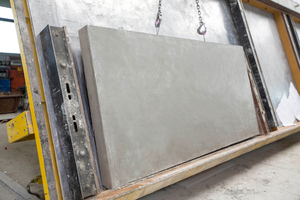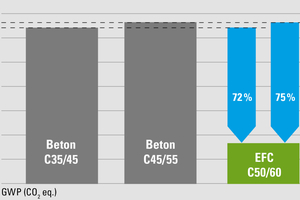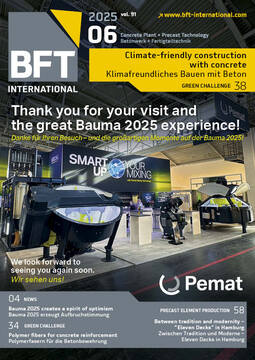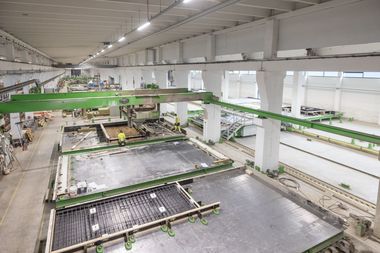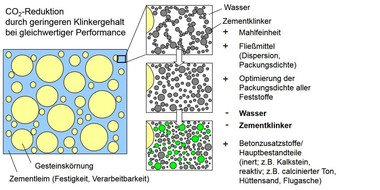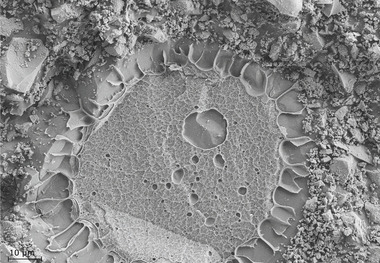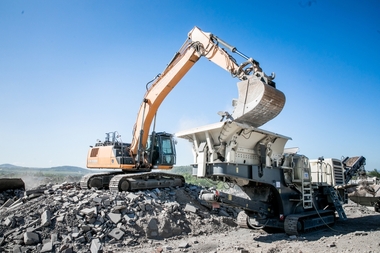Climate-friendly construction with concrete
Concrete is one of the most frequently used building materials and has a considerable share in global carbon emissions. Innovative materials such as the Earth Friendly Concrete provide environmentally friendly alternatives which are able to reduce the carbon footprint substantially due to the use of alternative raw materials.
Concrete is one of the most frequently used building materials and has a considerable share in global carbon emissions. Innovative materials such as the Earth Friendly Concrete provide environmentally friendly alternatives which are able to substantially reduce the carbon footprint due to the use of alternative raw materials.
Cement – Cause of carbon emissions in the construction industry
The topic of sustainability and carbon footprint and/or climate friendliness plays an ever more important role today as well as in the future. This is more and more also true for construction products and building structures. Therefore, the construction industry is looking for climate-friendly solutions, too. If we examine construction products in detail, it quickly becomes clear that the biggest proportion of carbon emissions is caused by binders. The main binder for construction products is cement. The production of cement is one of the greatest sources for carbon emissions all over the world, because large quantities of carbon dioxide are released in the production process. The production of cement startes with burning of limestone (chemical: CaCO3) at approx. 1,000 °C. In this process not only energy is consumed, but also carbon dioxide is dissociated as a side product, being released.
This is an important step because hydraulically active quicklime is formed as a result of the dissociation of carbon dioxide. Only in this way, it is possible that the cement reacts when getting in contact with water and is hardening – thus concrete is made eventually. If considering the entire carbon emissions of cement, then about two thirds emerge by the above described, inevitable reaction and one third by the input of energy and the firing process. Therefore, the biggest potential for saving carbon dioxide is in the reaction itself. So as to reduce carbon emissions in the construction sector, it is crucial to minimize the proportion of cement in the production of concrete.
Producing low-carbon building materials
A frequently applied method for the reduction of the carbon footprint of cement is the use of additives for reducing the clinker content. In this way, the proportion of the above described reaction in the binder is diminished. Latent hydraulic or pozzolanic binders are used instead of cement. The special characteristic of these additives is that they do not react with water alone, but do react and set because of the calcium hydroxide from the cement clinker. These binders are either secondary raw materials occurring in various industrial processes or, however, substances from natural occurrences of volcanic origin (e.g., trass, lava). They can be obtained from clays, slate or sedimentary rocks (phonolith).
When the clinker content in cement is reduced, the early strength declines under the same basic conditions. These effects are much more pronounced at low ambient temperatures. Owing to a possibly low early strength, the use of low-clinker cements, however, may also require to adapt the production processes and/or construction methods accordingly. An example for the cement classes outlined above are CEM I with 100 % clinker content and CEM/III A with partially only 40 % clinker content. Therefore, the carbon footprint of the concrete is halved by using of a CEM III/A concrete instead of a CEM I concrete. However, a basic content of clinker is always needed to enable a reaction.
Geopolymer concrete
Cement clinker is needed to make the additive react. One way to eliminate cement clinker completely is to let the additives react by chemical, alkaline activators. This type of concrete is called geopolymer concrete. Here, the major challenge is the use of the proper activators and the optimum dosage. This prevents uncontrolled reactions which would make it difficult to process the concrete because it could react too quickly or hardly at all. The right use of the additives in respect of the chemical composition, grinding fineness and the mixing ratio are essential for the geopolymer concrete, also called alkali-activated concrete.
For this reason, MC-Bauchemie has been working on this topic for more than ten years now and can provide a wide range of experience, above all, in the field of using activators and admixtures. Hence, not just one activator is used in all fields of application, on the contrary, they especially respond to the necessary requirements by combining activators and admixtures. In this way, it was already possible to manufacture all consistency classes ranging from earth-moist concrete products up to free-flowing concrete for various precast concrete applications accurately by using different combinations of activators. For the application in the field of precast concrete elements, demolding of the building components is possible as usual due to a precise composition of activators. In addition, the required processing time in ready-mixed concrete was exactly realized by the development of new superplasticizers. Another new development are release agents for the application in geopolymer, being a decisive topic in the precast concrete industry.
Tested, regulated, certified
If in Germany new construction products, which are not in compliance with the construction products regulation, are brought to the market, the manufacturer needs an approval. This is granted by the German Institute for Construction Technology (DIBt – Deutsches Institut für Bautechnik), among others. In this regard, the building codes of the German Federal States are aiming at the safety of building structures. To ensure this, it can be necessary to regulate, in addition to the product properties, the assembly of construction products to become a building structure or parts of structural installations („type of construction“). In cooperation with the Australian company Wagners, MC-Bauchemie has developed the first cement-free concrete, the so-called Earth Friendly Concrete (EFC). For this concrete, a DIBt approval (Z-3.15.2157) was granted for the first time in Germany in September 2019.
The exposure classes are an important aspect for the approval. The components for the geopolymer are allowed to be used in the production of concrete for exposure classes X0, XC1 to XC4, XF1 and XF3, XA1 to XA3, W0 and WF in compliance with DIN EN 206-1 in conjunction with DIN EN 1045-2. In normative terms, only specific basic materials of the EFC are governed such as ground-granulated blast furnace slag, fly ash or concrete admixtures. A national technical approval (abZ) has been obtained for the binder made from the same and from the activators. The EFC has to be approved for the respective case of application, for example, as part of an approval on a case-to-case basis in Norderstedt or the national technical approval for (reinforced) concrete pipes. The approvals specify the quality parameters that ensure a reliable use. On the basis of the EFC approval, the Next.Beton group, moreover, was able to obtain the first approval for cement-free pipes. Due to the great advantage of exposure class XA3, no further coating is necessary here and it is possible to eliminate plastic completely, which has a very high carbon footprint in comparison to the building material concrete. A building construction project in Norderstedt has as well been approved meanwhile. For this project approximately 3,000 m³ of cement were saved for the entire concrete, avoiding approx. 600,000 kg of carbon dioxide. Thus, it becomes obvious that rules and regulations for such projects are already available and are applied. This provides planners, clients and processors with safety.
Reducing the global warming potential
The life cycle analysis (LCA) of the Kiwa testing institute demonstrates the positive effects of such projects on the carbon footprint. Here it becomes apparent that the Earth Friendly Concrete generates a global warming potential of only 90 kg of CO2/m³ concrete. This assessment has already been taken all activators and superplasticizers into account. This is particularly noteworthy as a concrete of a high strength class of C50/60 is concerned here. Compared with this, industry references on the basis of cement are at more than 300 kg CO2/m³. Decisive factor for this high value is the use of CEM I cements which are assessed in the Environmental Product Declaration (EPD) with more than 800 CO2/t according to EN 15804 and ISO 14025.
Limits of availability = opportunity for innovations
Needless to say, the alternatives are not available in the same amounts as cement. They are not meant to replace cement completely. Because of the political decision of the last few years that all existing hard coal-fired power plants are to be shut down, it is foreseeable that no more fly ash will occur from hard coal-fired power plants in Germany. At the moment, this development is already clearly felt in concrete technology because the few remaining plants in some cases are only running intermittently.
As far as ground-granulated blast furnace slag is concerned, the steel production in Germany will be converted in the medium term, leading to a reduction of occurring blast-furnace slag in Germany. However, technological alternatives are available for both basic materials, as substitutions of the same. Similar to the conventional concrete technology, this can be calcinated clays and natural pozzolans, for example. But other synthetically manufactured products will also be available, which are comparable with the properties of a ground-granulated blast furnace slag in technical terms. So the requirement to use additional alternatives provides an exciting field for innovations of MC. Therefore, we are currently working intensively on the utilization of new resources which have not been considered for the construction industry so far. In this regard, our focus is on a sustainable circular economy.
Occupational safety
Since MC is a chemical manufacturer, the safety of humans and the environment always has priority. All developments are strongly focusing on occupational safety and health, so that future construction will not only be sustainable, but also safe. As the raw materials of the binder for the Earth Friendly Concrete are latent hydraulic and pozzolanic, they need an activator which activates the system by alkali. In case of cement concretes, the activation is generated by the calcium hydroxide from the clinker, with achieving a pH value of approx. 13. Therefore, personal protective equipment, preventing skin and eye contact, should be worn in case of conventional concrete, too. There are different approaches for an activation of cement-free concretes. In the market, often liquid components are used, which are extremely aggressive to the skin. In this case, the staff working in the production has to be very careful so as not to sustain chemical burns.
Therefore, MC is working with powders which do not react directly when in contact with the skin. The properties for an activation of the concrete only unfold when the activators are dissolved in water. In this way, safety of the production staff can be guaranteed and the concrete can achieve its ideal properties. To ensure that handling the powder is safe too, it is added to the concrete by means of a closed dosing unit. People are not required for this process. A great advantage of using powders is the fact that they are storage-stable and that, unlike comparable liquid activators, they need not be protected against coldness, to prevent them from crystallizing out. This is another advantage, since only the quantities needed for the current production of the day are used and the remaining quantities can be stored again. For the subsequent handling of the concrete, all those involved should again wear their personal protective equipment to prevent skin and eye contact.
A glance into the future
Within the construction project „UBS4“ realized by blu – Gesellschaft für nachhaltige Immobilienprojekte, a company of the Aug. Prien group, 71 homes will be built that are publicly funded. The entire concrete that is supplied there as ready-mixed concrete and/or used in the precast concrete elements is the cement-free EFC. The substitution of the cement by a geopolymer as binder allows, in this specific case, a significant reduction of the carbon footprint of the concrete components. The activators required for the reaction of the geopolymer and the concrete admixtures were supplied by MC.
The particular challenge here was that the project had already been planned completely with a cement concrete being in compliance with the relevant standards and the procedure had to be implemented in a short period immediately before the start of construction works. The numerous application examples (precast wall elements, floor slabs, stairs, columns, pipes, paving blocks and ready-mixed concrete) clearly show how versatile EFC can be used. They are all based on the existing national technical approval and are therefore tested down to the very detail. It can be built up on this wealth of experience in the future. Not only the existing mix designs will be an exciting topic for the future, but this knowledge can rather be used to continue to push forward the circular economy. Hence, waste raw materials which cannot be used today, may possibly be used as binders in the future, with taking a further step towards climate-friendly construction.

